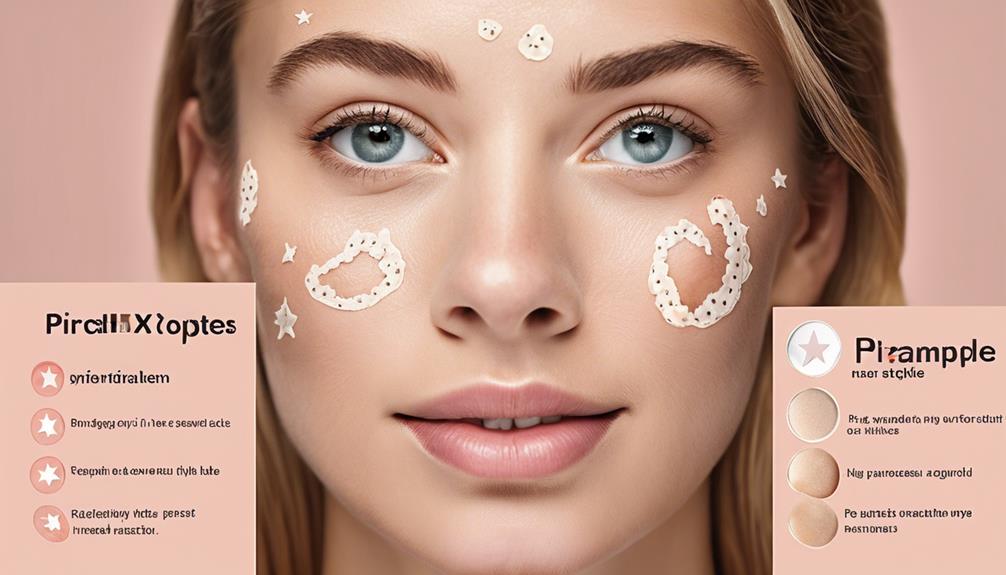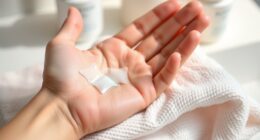When dealing with dry patches on your face, prioritizing hydration, gentle cleansing, and using key hydrating ingredients is essential. Hydration helps restore moisture, while gentle cleansing prevents irritation. Look for products containing hydrating ingredients like hyaluronic acid, ceramides, and glycerin to soothe and repair the skin barrier. Hyaluronic acid deeply hydrates, while ceramides lock in moisture. Hydrating serums and facial oils can provide extra nourishment. Also, remember to use sunscreen with at least SPF 30 daily. For persistent dry patches, consult a dermatologist for personalized recommendations and expert care. Learn how to best care for your skin and tackle dry patches effectively.
Key Takeaways
- Use hydrating products with hyaluronic acid, glycerin, and ceramides.
- Opt for gentle cleansing to avoid further irritation.
- Incorporate facial oils like argan, jojoba, or rosehip oil for extra hydration.
- Apply sunscreen daily with SPF 30 to protect and moisturize dry patches.
- Consult a dermatologist for persistent or worsening dry patches.
Understanding Dry Patches on Face
What exactly causes those rough, flaky patches on our faces? Dry patches on the face occur when our skin lacks proper moisture, resulting in an impaired skin barrier. Factors like harsh weather, over-exfoliation, and using drying skincare products can exacerbate these patches, leaving our skin feeling uncomfortable and looking irritated. It's vital to understand that these dry patches can be itchy and affect the overall texture of our skin. Seeking advice from a dermatologist can help pinpoint the root cause of these issues.
To combat dry patches on the face, hydration plays an important role. Ensuring our skin is well-moisturized and using gentle exfoliation techniques can help improve the skin's condition. Choosing skincare products specifically designed to provide hydration to the skin can also aid in preventing and treating dry patches effectively. By incorporating these practices into our skincare routine, we can work towards achieving smoother and healthier-looking skin.
Importance of Hydration for Dry Patches

To address dry patches on the face, prioritizing hydration becomes crucial in restoring moisture to the skin barrier. Hydration plays an important role in combating dry patches by replenishing lost water and improving the overall appearance and texture of the skin.
When the skin lacks hydration, dry patches can worsen, leading to discomfort and itchiness. By using skincare products containing hydrating ingredients, you can effectively target and moisturize these problem areas, ultimately achieving a healthier complexion.
Hydrating the skin not only helps in soothing dry patches but also enhances the skin's natural barrier function, promoting a smoother and more radiant look. Therefore, incorporating products that focus on hydration is essential in addressing dry patches on the face and maintaining the skin's overall health and vitality.
Gentle Cleansing for Dry Patches

When dealing with dry patches on the face, opting for a gentle cleansing approach is paramount to prevent further irritation and maintain skin hydration. Using a mild, hydrating cleanser is essential in this process.
Harsh cleansers can strip the skin of its natural oils, making dry patches worse. Look for non-foaming cleansers containing soothing ingredients like ceramides or hyaluronic acid to help replenish moisture and soothe irritated skin. Avoid scrubbing or using hot water, as these can exacerbate dry patches and increase skin sensitivity.
Consistent gentle cleansing is key to keeping the skin hydrated and aiding in the healing process of dry patches on the face. By choosing the right cleanser and being gentle with your skin, you can effectively manage dry patches and promote a healthier complexion.
Hydrating Ingredients for Dry Patches

Incorporating hydrating ingredients is essential for addressing dry patches on the face and promoting skin hydration.
Hyaluronic acid is a crucial ingredient that attracts and locks in moisture, leaving the skin plump and well-hydrated.
Glycerin, another key player, works as a humectant, drawing moisture into the skin to soothe and hydrate those pesky dry patches.
Ceramides play an important role in repairing the skin barrier and preventing water loss, making them a must-have for addressing dry patches effectively.
Aloe vera, with its soothing properties, can help calm and hydrate irritated dry patches, providing relief to the skin.
Vitamin B5, also known as panthenol, is a hydrating ingredient that not only boosts moisture retention but also enhances the skin's barrier function, making it a valuable addition to combat dry patches.
These ingredients work harmoniously to nourish and revitalize the skin, helping to restore a healthy, hydrated complexion.
Incorporating Hyaluronic Acid

When it comes to addressing dry patches on the face, incorporating hyaluronic acid can be a game-changer.
This powerful humectant has the ability to attract and retain moisture, providing a hydration boost to parched skin.
Hydration Boosting Benefits
To enhance hydration and rejuvenate dry patches on the face, harness the power of hyaluronic acid, a potent humectant known for its ability to attract and retain water, providing intense moisture and a plump, smooth complexion.
Hyaluronic acid deeply hydrates dry patches, reducing the appearance of fine lines and wrinkles in those sensitive areas. It's gentle on the skin, making it suitable for all skin types, including sensitive skin, without clogging pores or feeling heavy.
Application Techniques
For optimal hydration and effectiveness, make sure that hyaluronic acid products are applied onto damp skin, gently patting or pressing them in to allow deep penetration. This technique helps the skin absorb the moisture-locking properties of hyaluronic acid more efficiently, targeting those pesky dry patches on your face.
By avoiding harsh rubbing and instead opting for a delicate patting motion, you guarantee that the hydrating benefits reach deep into the skin, leaving it plump and smooth. Incorporating this method into your skincare routine can make a significant difference in combating dry patches and enhancing overall skin hydration.
Product Recommendations
Let's explore some top picks for skincare products that harness the hydrating power of hyaluronic acid to tackle dry patches on the face.
Hyaluronic acid is a key ingredient known for its ability to attract and retain moisture, making it perfect for hydrating those pesky dry patches.
When it comes to targeting fine lines and wrinkles caused by dryness, products with hyaluronic acid can work wonders by plumping and smoothing the skin.
Opt for serums, moisturizers, or masks that specifically incorporate this hydrating powerhouse to provide intense moisture to flaky areas on your face.
Regular use of hyaluronic acid-based products can greatly enhance the moisture levels and overall texture of dry patches, leading to a healthier and more radiant complexion.
Nourishing With Ceramides

Ceramides are essential for keeping our skin hydrated, repairing the skin barrier, and locking in moisture.
By using products rich in ceramides, we can replenish and strengthen our skin's natural protective layer.
These lipid molecules play an important role in retaining skin hydration and promoting overall skin health.
Ceramides for Hydration
Strengthening the skin barrier and enhancing hydration can be achieved by incorporating ceramides into our skincare routine. Ceramides, essential lipids found naturally in the skin, play a crucial role in maintaining the skin's barrier function and moisture levels. When included in skincare products, ceramides help fortify the skin barrier, reducing water loss and boosting hydration, especially beneficial for dry skin. Here's why ceramides are key for hydrating dry patches on the face:
- Retain Moisture: Ceramides help the skin hold onto moisture, preventing dryness.
- Repair Barrier: They replenish the skin's lipid barrier, promoting smoother and softer skin.
- Reduce Water Loss: Ceramides decrease water loss, keeping the skin hydrated.
- Enhance Hydration: Products containing ceramides effectively nourish and hydrate dry patches, improving overall skin health.
Repairing Skin Barrier
Nourishing our skin barrier with ceramides is essential for repairing and maintaining ideal hydration levels, especially in areas prone to dry patches. Ceramides, essential components of the skin barrier, play a pivotal role in moisture retention and skin repair.
By using products infused with ceramides, we can replenish and strengthen the skin barrier, reducing water loss and enhancing hydration. Research supports the effectiveness of ceramides in improving skin health, reducing dryness, and restoring the skin's protective barrier.
When combined with cholesterol and fatty acids, ceramides work synergistically to repair and fortify the skin barrier. Regular use of ceramide-based skincare products can lead to smoother, more hydrated skin, particularly in areas that are susceptible to dry patches.
Locking in Moisture
Regularly using skincare products infused with ceramides can greatly improve the hydration levels of dry patches on the face. Ceramides play an essential role in maintaining the skin's barrier and retaining moisture, making them indispensable for addressing dryness.
Here's why ceramides are pivotal for nourishing your skin:
- Ceramides replenish and repair the skin barrier, reducing water loss and enhancing hydration in dry areas.
- These lipids mimic natural skin oils, aiding in restoring and strengthening the skin's protective layer for smoother, more hydrated skin.
- Products with ceramides help alleviate symptoms like flakiness, roughness, and tightness associated with dry patches on the face.
- Consistent use of ceramide-rich skincare products promotes long-lasting hydration and overall skin health, particularly beneficial for treating dry patches effectively.
Hydrating Serums for Dry Patches

Enhancing your skincare routine with hydrating serums can effectively alleviate dry patches on your face, promoting a more hydrated and rejuvenated complexion. Hydrating serums are formulated with ingredients like hyaluronic acid and glycerin, which deeply penetrate the skin to boost moisture levels and target dry patches specifically. By replenishing lost hydration in these areas, these serums lead to smoother and more supple skin, restoring a healthy balance. They can be used alone or layered under moisturizers to enhance their effectiveness, providing an extra layer of hydration. Regular use of hydrating serums not only improves the appearance of dry patches but also helps prevent further skin dehydration. When choosing a hydrating serum, look for additional beneficial ingredients like vitamins and antioxidants for added skin nourishment.
| Hydrating Serums | Benefits | Key Ingredients |
|---|---|---|
| Deep Hydration | Smoothens skin | Hyaluronic Acid |
| Target Dry Patches | Supple complexion | Glycerin |
| Skin Rejuvenation | Prevents dehydration | Vitamins |
Facial Oils for Extra Hydration

Facial oils like argan, jojoba, and rosehip oil are packed with essential fatty acids and antioxidants that deeply hydrate dry patches on the face. These oils work to nourish and repair the skin barrier, helping to restore moisture and improve skin texture effectively.
Hydrating Benefits of Oils
When aiming to achieve extra hydration for dry patches on the face, incorporating facial oils like argan oil, jojoba oil, and rosehip oil can be highly beneficial. Here are some key benefits of using facial oils for intense hydration:
- These oils contain fatty acids that help repair the skin barrier.
- Facial oils lock in moisture for long-lasting hydration.
- Argan oil is rich in vitamin E and antioxidants, nourishing and protecting the skin.
- Jojoba oil closely resembles the skin's natural oils, ideal for balancing moisture levels in dry patches.
Using these facial oils can't only hydrate dry patches but also promote healthy and radiant skin.
Best Oils for Face
For achieving ideal hydration on dry patches, incorporating facial oils such as argan oil, jojoba oil, and rosehip oil is essential. These face oils are rich in fatty acids and antioxidants, providing deep nourishment and aiding in repairing the skin barrier.
Argan oil stands out for its anti-inflammatory properties, which can help soothe and calm dry, irritated patches effectively. Jojoba oil, with its similarity to the skin's natural sebum, is fantastic for balancing and hydrating dry skin areas, leaving them feeling soft and supple.
Additionally, rosehip oil, loaded with vitamins A and C, works wonders in promoting skin regeneration and brightening dark spots on dry patches. When it comes to combating dryness and achieving extra hydration, these facial oils are true skin saviors.
Sunscreen Protection for Dry Patches

To shield dry patches on the face from harmful UV rays and prevent skin damage, applying sunscreen regularly is crucial. Here are some important tips to keep in mind when using sunscreen for dry patches:
- Choose Wisely: Opt for a broad-spectrum sunscreen with at least SPF 30 to safeguard your skin from both UVA and UVB rays, ensuring thorough protection.
- Regular Application: Apply sunscreen every 2 hours, especially when exposed to the sun, to maintain the skin barrier's integrity and prevent further dryness and irritation.
- Hydration Boost: Look for sunscreens with moisturizing ingredients like hyaluronic acid or glycerin to provide extra hydration to dry patches while offering sun protection.
- Thorough Coverage: Make sure that all exposed areas of your face, including dry patches, are properly covered with sunscreen to guard against sun damage and premature aging.
Dermatologist Recommendations for Dry Patches

To address dry patches effectively, dermatologists often recommend utilizing gentle, hydrating cleansers to prevent further skin dryness. Hydrating cleansers help to cleanse the skin without stripping it of essential moisture, which is vital for individuals with dry skin.
Moisturizers containing ceramides, hyaluronic acid, and glycerin are also highly recommended for hydrating dry patches on the face and restoring the skin's barrier function. These ingredients help to lock in moisture and prevent water loss, promoting smoother and more supple skin.
When dealing with dry patches, it's important to avoid harsh exfoliants or scrubs that can exacerbate the condition and lead to irritation. Instead, dermatologists may suggest using targeted treatments like serums or creams specifically formulated to address dry, flaky patches on the face.
If dry patches persist or worsen despite home care efforts, seeking professional help from a dermatologist is essential to determine the underlying cause and establish an effective treatment plan.
Frequently Asked Questions
How Do I Get Rid of Extreme Dry Patches on My Face?
To effectively address extreme dry patches on the face, gently exfoliating with ingredients like lactic acid or urea to remove dead skin cells is crucial.
Hydrating the skin with a rich moisturizer containing ceramides and hyaluronic acid can nourish and repair the patches.
It's important to avoid harsh ingredients like alcohol, fragrance, and sulfates to prevent further irritation.
If the issue persists, consulting a dermatologist for personalized treatment options is recommended.
How Do You Rehydrate Dry Skin Patches?
To rehydrate dry skin patches, we recommend using a gentle cleanser and moisturizer with ingredients like hyaluronic acid or ceramides. Face oils with nourishing fatty acids, such as argan oil, can also help repair and hydrate dry patches.
Consider using non-abrasive exfoliants with lactic acid or fruit enzymes to remove flaky skin gently. Additionally, incorporating hydrating sheet masks with aloe vera or collagen can provide an extra boost of moisture to dry patches.
What Cream Is Good for Rough Patches on Face?
We recommend creams with ceramides, glycerin, and hyaluronic acid for rough patches on the face. Shea butter, squalane, and niacinamide are also great for soothing dry areas.
Avoid harsh ingredients like alcohol and fragrances that can irritate. Opt for non-comedogenic options to prevent pore clogging.
Consulting a dermatologist can provide personalized recommendations. Remember, hydration and gentle care are key in addressing rough patches on the face.
What Do Dermatologists Recommend for Extremely Dry Skin on Face?
Dermatologists recommend gentle, non-foaming cleansers for extremely dry skin on the face to avoid stripping natural oils.
Hydrating serums with ingredients like hyaluronic acid can replenish moisture and improve skin hydration.
Moisturizing with rich creams containing occlusives like shea butter or argan oil prevents water loss and soothes dry patches effectively.
Avoid harsh exfoliants or drying ingredients to prevent irritation.
Seeking professional advice may be necessary for managing extremely dry skin on the face.
Can Marine Skincare Acne Patches Also Help with Dry Patches on the Face?
Yes, marine skincare acne patches can also help with dry patches on the face. These patches are designed to not only target acne but also provide hydration to the skin. The marine ingredients in the patches can help nourish and moisturize dry patches, leaving the skin balanced and healthy. Additionally, the unique formulation of these patches ensures that they adhere well to the skin, allowing the active ingredients to penetrate deeply and work effectively. For those curious about other skincare products, you might consider looking into a generation skins eye patches review to learn more about their efficacy in addressing under-eye concerns. Overall, incorporating marine skincare acne patches into your routine can provide comprehensive benefits, helping to achieve a more radiant and hydrated complexion.
Conclusion
To sum up, for flawless facial hydration, embrace gentle cleansing, hydrating serums, and facial oils.
Protect with sunscreen for perfect skin harmony.
Let's lavish our faces with love and moisture for a radiant, rejuvenated glow!










